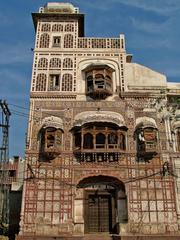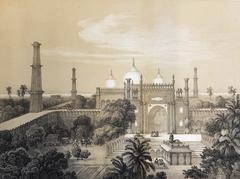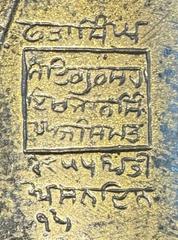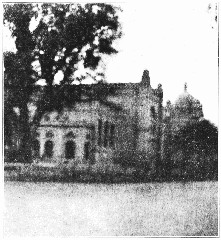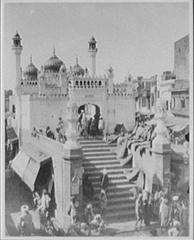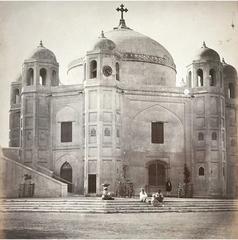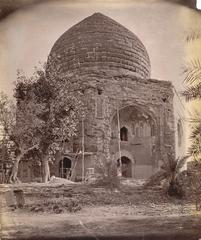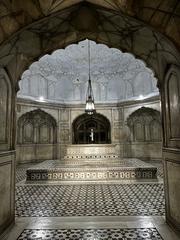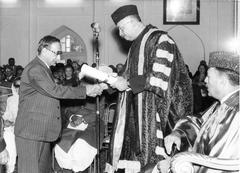
Moti Masjid Lahore: Visiting Hours, Tickets, and Historical Guide
Date: 03/07/2025
Introduction
Nestled within the storied walls of the Lahore Fort, Moti Masjid—also called the Pearl Mosque—is a luminous jewel of Mughal architecture and a vital part of Pakistan’s cultural heritage. Built from gleaming white Makrana marble between 1630 and 1635 CE under Jahangir and Shah Jahan, this serene mosque was designed as a private sanctuary for the royal household. With its harmonious proportions, five cusped arches, and three graceful domes, Moti Masjid stands as both a spiritual haven and a testament to the Mughal era’s aesthetic mastery. Today, it draws architecture enthusiasts, historians, and spiritual seekers alike.
This guide provides all the essential information for visiting Moti Masjid, including updated hours, ticketing details, architectural highlights, accessibility tips, and guidance for a respectful and enriching visit. It also covers the mosque’s historical transformations, spiritual significance, and its place within Lahore Fort’s UNESCO-listed legacy. Whether you are planning a first-time visit or seeking deeper historical context, this article is your comprehensive resource for experiencing Moti Masjid’s timeless beauty. (Official Lahore Fort Website, UNESCO’s Lahore Fort listing, Wikipedia, Graana, Pakyatra, gypsytours.pk)
Table of Contents
- Historical Background
- Architectural Features
- Visiting Moti Masjid: Hours, Tickets & Tips
- Cultural and Spiritual Significance
- Visitor Etiquette and Responsible Tourism
- FAQ
- Conclusion and Call to Action
- Sources and Further Reading
Historical Background
Origins and Construction
Moti Masjid was constructed between 1630 and 1635 CE, initiated by Emperor Jahangir and completed under Shah Jahan (Wikipedia). It was among the earliest Mughal mosques named after precious stones, a trend followed by later imperial mosques such as the Moti Masjid in Delhi’s Red Fort and the Nagina Masjid in Agra (Graana). Originally, it served as a private prayer space for the royal harem and the emperor, emphasizing exclusivity and spiritual intimacy (Pakyatra).
Historical Transformations
- Mughal Era: Moti Masjid functioned as an intimate royal sanctuary within the Lahore Fort, embodying the spiritual life of the Mughal court (Pakyatra).
- Sikh Rule: During the late 18th and early 19th centuries under Maharaja Ranjit Singh, the mosque was converted into a Sikh temple (“Moti Mandir”) and later used as a treasury (Wikipedia, Graana).
- British Colonial Period: Following the British annexation of Punjab in 1849, the mosque was restored for Islamic worship and underwent significant conservation (Wikipedia).
Architectural Features
White Marble Construction
Moti Masjid’s most distinguishing feature is its use of pure white Makrana marble, symbolizing purity and opulence. This choice sets it apart from other Mughal mosques, which often use red sandstone with marble inlay (Wikipedia). The marble’s subtle sheen enhances the mosque’s tranquil aura.
Façade, Arches, and Domes
The mosque’s façade is defined by five elegant cusped arches—an uncommon design in Mughal architecture, which typically uses three. The central arch is slightly more prominent, providing a stately focus. Three bulbous domes rest on octagonal drums, topped with lotus finials, reinforcing the mosque’s harmonious and balanced proportions (Graana, Scribd).
Interior Layout and Ornamentation
The prayer hall is a modest, rectangular space divided into three bays, each crowned by a dome. The interior features a beautifully carved marble mihrab and minbar with understated floral and geometric motifs. Ornamentation is subtle, allowing the natural beauty of the marble and the interplay of light and shadow to create a spiritually uplifting atmosphere (Wikipedia).
Adaptive Reuse and Restoration
Despite its conversion and use as a treasury during Sikh and British rule, Moti Masjid’s core structure and marble work survived. Restoration efforts—most notably in the late 19th and early 20th centuries—returned the mosque to its original function, preserving its historic character for future generations (Scribd).
Visiting Moti Masjid: Hours, Tickets & Tips
Visiting Hours
Moti Masjid is open daily from 9:00 AM to 5:00 PM. Hours may vary on public holidays or during religious events; check the Official Lahore Fort Website for real-time updates.
Entry Fees and Tickets
- Foreign Visitors: PKR 500 (subject to change)
- Local Visitors: PKR 50–100 (subject to change)
- Children under 12: Usually discounted/free; confirm at the ticket counter
Tickets are sold at the Lahore Fort main entrance and via authorized online platforms. Entry to Moti Masjid is included in the Lahore Fort admission ticket (Graana).
Accessibility
The mosque is accessible via paved walkways within the fort, but several steps and uneven surfaces may pose challenges for visitors with mobility impairments. As of 2024, there are no ramps directly to the prayer area. Wheelchair users may require assistance (moti-masjid.placyo.com).
Guided Tours
Licensed guides are available at Lahore Fort for an enriched experience. Guided tours typically include Moti Masjid, Sheesh Mahal, and other key sites, providing historical, architectural, and cultural insights. Audio guides and informational plaques are also available (gypsytours.pk).
Best Time to Visit & Photography
The ideal time to visit is October to March for cooler temperatures. Early mornings and late afternoons offer the best natural light for photography and a more peaceful atmosphere. Photography is permitted but avoid flash or tripods unless you have special permission.
Nearby Attractions
Within Lahore Fort, don’t miss Sheesh Mahal, Alamgiri Gate, Naulakha Pavilion, and the Diwan-e-Aam. Outside the fort, explore Badshahi Mosque, Wazir Khan Mosque, and the Tomb of Allama Iqbal for a broader cultural experience (thetouristchecklist.com).
Cultural and Spiritual Significance
Moti Masjid holds deep spiritual value as a functioning mosque and a living heritage site. Its compact, peaceful design encourages contemplation and prayer, while its marble purity reflects Mughal ideals of piety and refinement. The mosque continues to play a role in local religious life and is a symbol of Lahore’s rich, pluralistic past (journals.umt.edu.pk).
Visitor Etiquette and Responsible Tourism
- Dress Code: Modest attire is required; women should cover their heads, arms, and legs. Scarves are often available at the entrance.
- Shoes: Remove shoes before entering the prayer area.
- Behavior: Maintain silence, avoid eating or drinking, and respect worshippers.
- Preservation: Do not touch or lean on carvings, write on walls, or leave litter. Report any vandalism to authorities.
During Islamic festivals and on Fridays, access may be limited to worshippers. Respect all restrictions and posted guidelines to help preserve this historic site.
FAQ
Q: What are Moti Masjid’s visiting hours?
A: 9:00 AM to 5:00 PM daily; check for seasonal changes or special event closures.
Q: What is the entry fee?
A: PKR 500 for foreigners, PKR 50–100 for locals; children may have discounts.
Q: Is Moti Masjid wheelchair accessible?
A: Partial access only; steps and uneven paths present challenges.
Q: Are guided tours available?
A: Yes, through Lahore Fort’s official guides.
Q: Is photography allowed?
A: Yes, but avoid flash and be mindful of worshippers.
Conclusion and Call to Action
Moti Masjid is not only an architectural gem but also a living testament to Lahore’s Mughal legacy and spiritual heritage. Its serene marble prayer hall, rich history, and carefully preserved details make it a top destination for travelers, historians, and local visitors alike. By following responsible tourism practices and respecting the mosque’s sanctity, you help ensure that this Pearl Mosque remains a beacon of beauty and history for generations to come.
Plan your visit today—download the Audiala app for guided tours, real-time updates, and exclusive content on Lahore’s heritage. Follow us on social media for the latest travel tips and cultural stories, and share your experience to inspire others.
Sources and Further Reading
- Moti Masjid Lahore Fort: History, Architecture, Visiting Hours & Travel Tips (Graana)
- Visiting Moti Masjid Lahore Fort: Hours, Tickets, and Architectural Highlights (Scribd)
- Cultural and Religious Significance (Gypsy Tours)
- Moti Masjid Visiting Hours, Tickets, and Guide to Lahore’s Historic Pearl Mosque (The Tourist Checklist)
- Moti Masjid (Lahore Fort) (Wikipedia)
- Lahore Fort - UNESCO World Heritage Centre
- Official Lahore Fort Website
- Pakyatra, Moti Mosque
- Moti Masjid official site and visitor information




